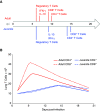Age-Dependent Differences in T-Cell Responses to Influenza A Virus
- PMID: 32609537
- PMCID: PMC7528914
- DOI: 10.1165/rcmb.2020-0169TR
Age-Dependent Differences in T-Cell Responses to Influenza A Virus
Abstract
Respiratory infections from influenza A virus (IAV) cause substantial morbidity and mortality in children relative to adults. T cells play a critical role in the host response to IAV by supporting the innate and humoral responses, mediating cytotoxic activity, and promoting recovery. There are age-dependent differences in the number, subsets, and localization of T cells, which impact the host response to pathogens. In this article, we first review how T cells recognize IAV and examine differences in the resting T-cell populations between juveniles and adults. Next, we describe how the juvenile CD4+, CD8+, and regulatory T-cell responses compare with those in adults and discuss the potential physiologic and clinical consequences of the differences. Finally, we explore the roles of two unconventional T-cell types in the juvenile response to influenza, natural-killer T cells and γδ T cells. A clear understanding of age-dependent differences in the T-cell response is essential to developing therapies to prevent or reverse the deleterious effects of IAV in children.
Keywords: T cell; age-dependent; influenza; juvenile; viral pneumonia.
Figures




Similar articles
-
CCR2 Regulates Vaccine-Induced Mucosal T-Cell Memory to Influenza A Virus.J Virol. 2021 Jul 12;95(15):e0053021. doi: 10.1128/JVI.00530-21. Epub 2021 Jul 12. J Virol. 2021. PMID: 33952647 Free PMC article.
-
Silent Infection of B and CD8+ T Lymphocytes by Influenza A Virus in Children with Tonsillar Hypertrophy.J Virol. 2020 Apr 16;94(9):e01969-19. doi: 10.1128/JVI.01969-19. Print 2020 Apr 16. J Virol. 2020. PMID: 32075928 Free PMC article.
-
Dendritic cells and influenza A virus infection.Virulence. 2012 Nov 15;3(7):603-8. doi: 10.4161/viru.21864. Epub 2012 Oct 17. Virulence. 2012. PMID: 23076333 Free PMC article. Review.
-
Deficiency of the NOD-Like Receptor NLRC5 Results in Decreased CD8+ T Cell Function and Impaired Viral Clearance.J Virol. 2017 Aug 10;91(17):e00377-17. doi: 10.1128/JVI.00377-17. Print 2017 Sep 1. J Virol. 2017. PMID: 28615208 Free PMC article.
-
Clearance of influenza virus infections by T cells: risk of collateral damage?Curr Opin Virol. 2013 Aug;3(4):430-7. doi: 10.1016/j.coviro.2013.05.002. Epub 2013 May 27. Curr Opin Virol. 2013. PMID: 23721864 Review.
Cited by
-
Pathogenesis of influenza and SARS-CoV-2 co-infection at the extremes of age: decipher the ominous tales of immune vulnerability.Adv Biotechnol (Singap). 2025 Jan 21;3(1):5. doi: 10.1007/s44307-025-00057-9. Adv Biotechnol (Singap). 2025. PMID: 39883362 Review.
-
Update in Pediatrics 2020.Am J Respir Crit Care Med. 2021 Aug 1;204(3):274-284. doi: 10.1164/rccm.202103-0605UP. Am J Respir Crit Care Med. 2021. PMID: 34126039 Free PMC article. No abstract available.
-
Similar humoral responses but distinct CD4+ T cell transcriptomic profiles in older adults elicited by MF59 adjuvanted and high dose influenza vaccines.Sci Rep. 2024 Oct 18;14(1):24420. doi: 10.1038/s41598-024-75250-2. Sci Rep. 2024. PMID: 39424894 Free PMC article.
-
Vimentin modulates regulatory T cell receptor-ligand interactions at distal pole complex, leading to dysregulated host response to viral pneumonia.Cell Rep. 2024 Dec 24;43(12):115056. doi: 10.1016/j.celrep.2024.115056. Epub 2024 Dec 7. Cell Rep. 2024. PMID: 39645657 Free PMC article.
-
RKIP suppresses the influenza A virus‑induced airway inflammatory response via the ERK/MAPK pathway.Int J Mol Med. 2023 Jan;51(1):1. doi: 10.3892/ijmm.2022.5204. Epub 2022 Nov 16. Int J Mol Med. 2023. PMID: 36382638 Free PMC article.
References
-
- World Health Organization. Geneva, Switzerland: World Health Organization; 2018. Fact sheets: influenza (seasonal) [accessed 2020 Jan 23]. Available from: https://www.who.int/en/news-room/fact-sheets/detail/influenza-(seasonal)
-
- Nair H, Brooks WA, Katz M, Roca A, Berkley JA, Madhi SA, et al. Global burden of respiratory infections due to seasonal influenza in young children: a systematic review and meta-analysis. Lancet. 2011;378:1917–1930. - PubMed
-
- Centers for Disease Control and Prevention FluView Interactive: influenza-associated pediatric mortality Atlanta, GA: Centers for Disease Control and Prevention; 2020[accessed 2020 Jan 23]. Available from: https://gis.cdc.gov/GRASP/Fluview/PedFluDeath.html
Publication types
MeSH terms
Grants and funding
LinkOut - more resources
Full Text Sources
Medical
Research Materials

